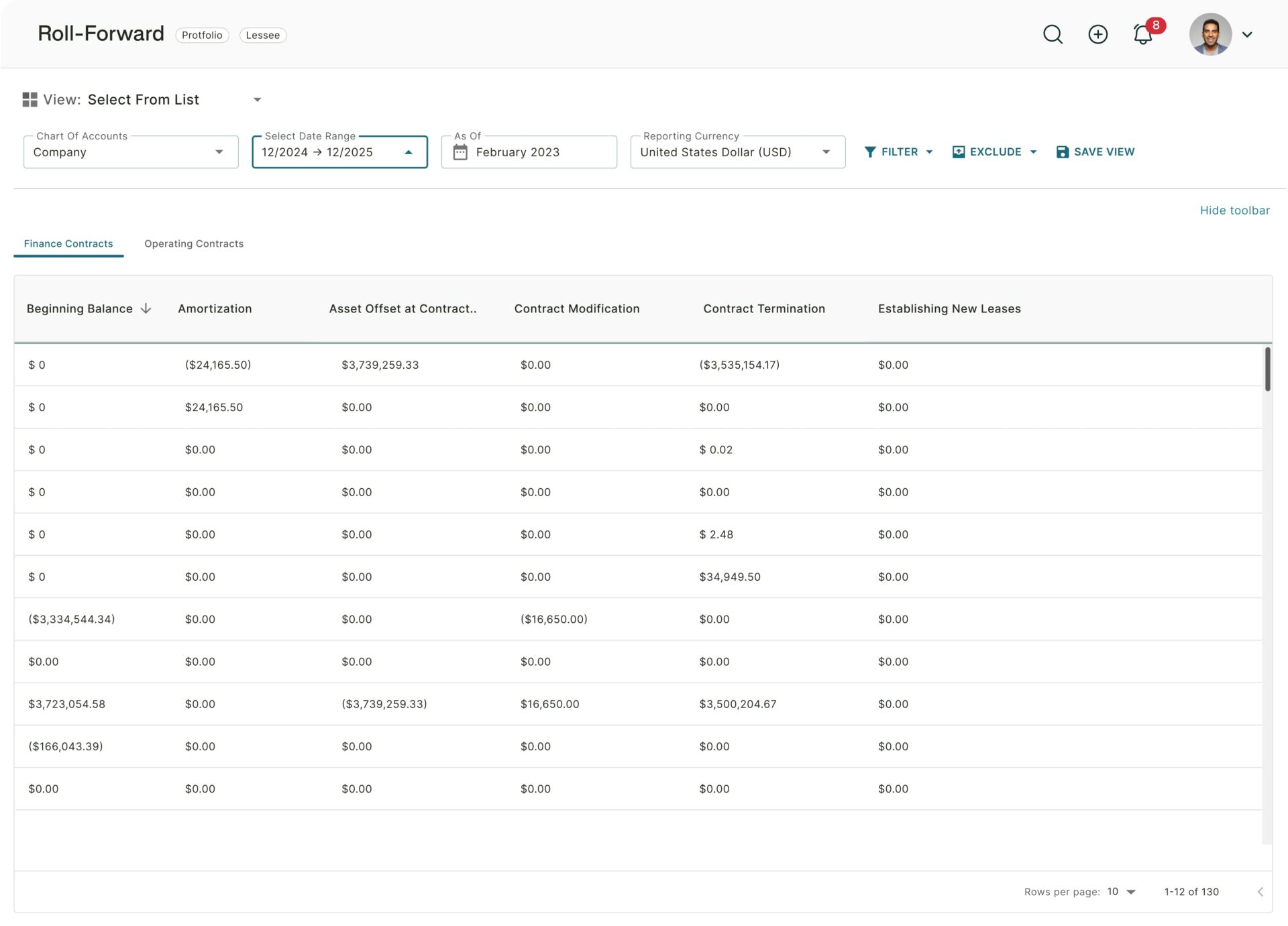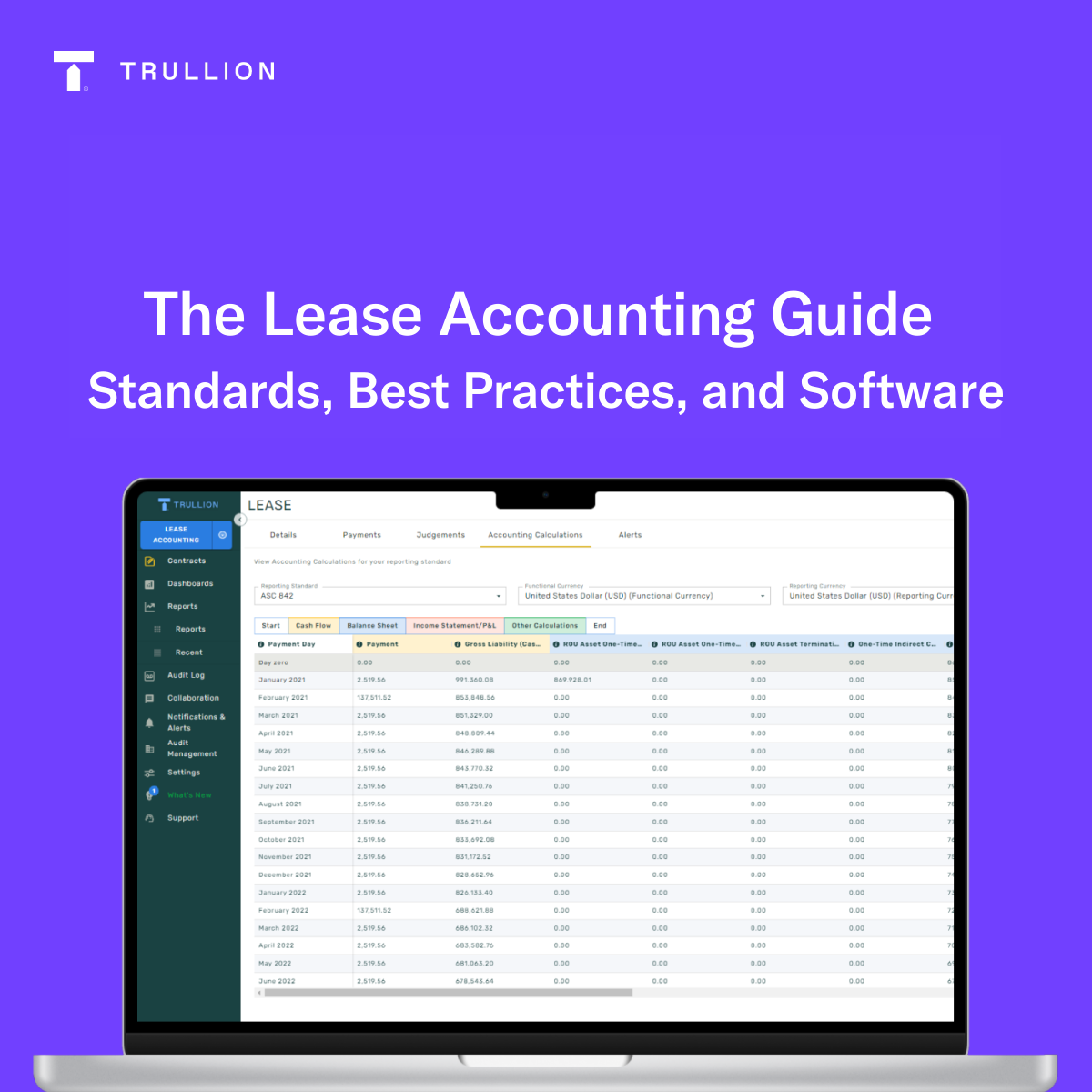What is lease accounting?
Lease accounting is the process of recording and reporting the financial impact of lease agreements on an organization’s financial statements. Common examples of leased assets include office or retail space, manufacturing equipment, vehicles, and IT equipment.
A lease is a contract in which one party (the lessee) pays to use an asset owned by another party (the lessor) for a specified period.
- A lessee records a right-of-use (ROU) asset and a lease liability to reflect their obligation to make lease payments and their right to use the asset.
- A lessor records lease income and classifies leases depending on whether risks and rewards of ownership transfer to the lessee.
Why is lease accounting important?
Lease accounting has become a central priority for companies, auditors, and consultants due to new global standards that significantly changed how leases are reported. In the United States, the Financial Accounting Standards Board (FASB) introduced ASC 842, while the International Accounting Standards Board (IASB) issued IFRS 16 for international entities, and government organizations follow GASB 87.
These standards require organizations to bring most leases onto the balance sheet, and they fundamentally reshape financial reporting, transparency, and compliance expectations.
Operating lease vs. financial lease: What are the differences in classifications?
Historically, finance leases appeared on the balance sheet, while operating leases were simply expensed through the income statement. Under ASC 842, IFRS 16, and GASB 87, almost all leases must now be recognized on the balance sheet.
Under ASC 842, a lease is classified as a finance lease if it meets any one of the standard’s criteria. Otherwise, it is an operating lease. Both types require balance sheet recognition, but they differ in expense presentation and treatment over time.
A lease is classified as a finance lease under ASC 842 if any one of the following criteria is met:
- Ownership of the underlying asset transfers to the lessee at the end of the lease term.
- The lease grants a purchase option that the lessee is reasonably certain to exercise.
- The lease term covers the majority of the asset’s remaining economic life.
- The present value of lease payments is equal to or exceeds the asset’s fair value.
- The asset is specialized and expected to have no alternative use to the lessor at lease end.
What are the new lease accounting standards?
There are three primary standards governing lease accounting today: ASC 842, IFRS 16, and GASB 87. ASC 842 and IFRS 16 were introduced to increase transparency around leasing activities by bringing most leases onto the balance sheet. While the standards share similar objectives, they differ in classification models, transition options, and subsequent measurement requirements.
Summary of ASC 842
ASC 842 requires companies to recognize a lease liability and a right-of-use (ROU) asset at lease commencement.
- Lease Liability = total value of payments x discount rate. The lease liability is measured at the present value of future lease payments, discounted using the rate in the lease. If that value is unavailable, it’s measured at the lessee’s incremental borrowing rate.
- Right-of-use (ROU) asset value = initial liability + initial direct costs + payments before commencement – incentives.
ASC 842 also provides guidance on lease modifications, remeasurement requirements, and expanded disclosure expectations.
Summary of IFRS 16
Although IFRS 16 aligns closely with ASC 842, there are key differences:
- Transition approach. IFRS 16 allows both retrospective and modified retrospective transition methods. ASC 842 allows only a modified retrospective approach but provides flexibility in the transition date.
- Leases on the balance sheet. IFRS 16 permits an exemption for low-value leases (typically assets under $5,000 when new), which ASC 842 does not.
- Lease classification. IFRS 16 uses a single lessee accounting model: nearly all leases are treated like finance leases. ASC 842 maintains operating vs. finance lease classification for lessees.
- Remeasurement. Changes in payments linked to an index or rate require remeasurement under IFRS 16, but generally not under ASC 842 unless triggered by a significant event.
- Sale-leaseback transactions. IFRS 16 restricts revenue recognition when a repurchase option exists. ASC 842 may allow full gain recognition if the transaction qualifies as a sale.
- Subleases. ASC 842 classifies subleases by referencing the underlying asset. IFRS 16 classifies by referencing the ROU asset, which can lead to differing classifications.
Summary of GASB 76
GASB 87 aligns with the principles of ASC 842 and IFRS 16.
- It requires lessees to recognize a lease liability (PV of expected payments minus incentives), and recognize a lease asset (based on the liability plus payments made before the start date).
- The asset is amortized over the shorter of the asset’s useful life or lease term.
- Disclosure requirements include descriptions of leasing arrangements, recognized assets and liabilities, and schedules of future lease payments.
Key differences: IFRS 16 vs ASC 842
ASC 842 retains a dual-model approach for lessees, distinguishing between operating and finance leases. Both types require recognition of a right-of-use (ROU) asset and a lease liability, with differing expense recognition patterns.
IFRS 16 uses a single lessee accounting model. Except for low-value and short-term leases, all leases are treated similarly to finance leases, with separate interest and depreciation expenses recognized.
There are key specific differences:
- Classification: ASC 842 distinguishes operating vs. finance leases; IFRS 16 generally does not.
- Low-value asset exemption: IFRS 16 allows it; ASC 842 does not.
- Remeasurement requirements: IFRS 16 requires more frequent remeasurement for index-linked payments.
- Transition: IFRS 16 permits full retrospective or modified retrospective approaches; ASC 842 allows only modified retrospective, with options for the transition date.
- Sale-leaseback treatment: IFRS 16 generally restricts gain recognition more than ASC 842.
Lessee vs. lessor under ASC 842
There are significant differences in lease accounting for lessees and lessors.
Lessee accounting
Lessees should include: general descriptions of leases, terms and conditions of variable leases and options to extend or terminate leases, residual value guarantees, and any restrictions or covenants imposed by lease agreements.
ASC 842 introduced substantial changes for lessees, shifting most leases onto the balance sheet and expanding disclosure requirements.
- Recognition. At commencement, lessees record a right-of-use (ROU) asset and a lease liability.
- Initial measurement. The lease liability is the present value of future payments. The ROU asset is the lease liability ± adjustments for payments, incentives, and initial direct costs.
- Subsequent measurement. The lease liability is updated for interest and payments, while the ROU asset is amortized, adjusted for accruals/incentives, and tested for impairment.
- Disclosures. In addition to leases that have commenced, these should also cover leases that haven’t yet commenced – but that will create significant rights and obligations, along with assumptions made and how the discount rate used was determined. Lessees must disclose:
- General descriptions of leases
- Key judgments and assumptions
- Variable lease terms
- Options to extend or terminate
- Residual value guarantees
- Non-commenced leases that create future obligations
Lessor accounting
Lessors classify leases into operating leases, sales-type leases, and direct financing leases. The following are required by ASC 842:
- Recognition. At commencement, the lessor defers initial direct costs. After that, lease payments are recognized as income on a straight-line basis over the lease term, unless another method is more appropriate. Variable lease payments are recognized in the period when the underlying variability factors occur.
- Measurement. For both initial and subsequent measurement, lessors should continue to measure the underlying asset in accordance with the relevant accounting guidance, including performing impairment testing when required.
- Disclosure. Lessors must provide qualitative and quantitative information about their leases as required by ASC 842. Disclosures should cover: the leases themselves, significant judgments made, and amounts recognized in the financial statements related to those leases.
- Additional disclosures. Lessors must also provide a general description of their leases, including terms for variable lease payments, options to extend or cancel, and conditions under which the underlying asset may be purchased. General disclosure requirements, such as related-party information, also apply.
What is operating lease accounting under ASC 842?
ASC 842 introduces specific requirements for accounting for operating leases. Key elements include:
Recognition
- Classification. At the commencement date, each lease component must be classified. If the lease does not meet any finance lease criteria, it is classified as an operating lease.
- Lease modifications. Modifications may require accounting for the revised contract as a new, separate lease. ASC 842 provides the applicable test (842-10-25-8).
Initial measurement
- Lease term. The lease term includes the non-cancellable period plus any optional extension periods that the lessee is reasonably certain to exercise, periods with termination options unlikely to be exercised, and any periods controlled by the lessor.
- Lease payments. Fixed and variable payments are included as defined in ASC 842 (842-10-30-5). The rate implicit in the lease is used when determinable; otherwise the incremental borrowing rate applies.
- Initial direct costs. Costs that would have been incurred regardless of whether the lease was executed, such as overhead, advertising, and legal or tax advice, are excluded.
- Right-of-use (ROU) asset. This value is measured using the initial lease liability, adjusted for pre-commencement lease payments (net of incentives) and initial direct costs.
Subsequent measurement
- Lease liability and ROU asset. The lease liability is updated using the present value of outstanding lease payments. The ROU asset is measured using the lease liability and adjusted for factors specified in ASC 842, such as prepaid or accrued lease payments, incentives, and other required elements.
- Remeasurement. This is required when a lease modification occurs that affects the lease term or lease payments.
Disclosure
- Balance sheet. Entities must separately present or clearly identify operating lease assets and liabilities (current and noncurrent).
- Income statement. This reflects lessee operating lease expenses.
- Cash flow statement. This presents cash payments related to operating leases.
- General disclosures. This provide qualitative and quantitative information about leases, significant judgments made, and amounts recognized in the financial statements.
Difference between old and new lease accounting standards
Under prior standards, only finance (capital) leases were recorded on the balance sheet, while operating leases were expensed as incurred. ASC 842 and IFRS 16 now require lessees to recognize a lease liability and ROU asset for most leases, significantly increasing reported assets and liabilities and improving visibility into long-term commitments.
Lease accounting examples
Operating lease example: A company enters into a 5-year office lease with annual payments of $50,000 and uses a 5% discount rate.
- Calculate the present value (PV) of lease payments. The PV of the five annual payments is recorded as the initial lease liability.
- Create the initial journey entry. The debit is the ROU asset equal to the initial lease liability, adjusted for payments, incentives, and direct costs. The credit is the lease liability.
- Record year 1 accounting. Operating leases under ASC 842 record a single straight-line lease expense each period: Lease expense = total payments ÷ lease term. The lease liability is reduced by lease payments, and the ROU asset is amortized so that total expense remains straight-line.
Finance lease example: A company leases equipment and the contract meets one of ASC 842’s finance lease criteria (e.g., ownership transfers at lease end).
- Calculate initial measurement. The calculation of PV and initial recognition mirrors the operating lease example.
- Record year 1 accounting. Finance leases separate expenses into interest expense on the lease liability, and depreciation expense on the ROU asset.
- Compare to operating lease. Although total cash paid is the same, finance leases typically show higher expense in early years (due to interest), and lower expense in later years.
Lease accounting challenges and best practices
Organizations often encounter common challenges including:
- Collecting lease data from decentralized locations
- Determining appropriate discount rates (e.g., incremental borrowing rates)
- Tracking and accounting for lease modifications
- Meeting expanded disclosure requirements
- Managing large lease portfolios with manual processes or spreadsheets
Best practices to support accurate and efficient lease accounting include:
- Centralize lease data in a single, controlled repository
- Establish clear accounting policies for classification, discount rates, and modifications
- Implement review and approval controls over key judgments and calculations
- Plan for ongoing compliance, not just initial implementation
- Leverage automation technologies that streamline data extraction, calculations, and reporting
What is lease accounting software? Making leasing easier with automation
As lease accounting standards such as ASC 842 have grown more complex, manual processes have become increasingly inefficient and prone to errors. Lease accounting software helps organizations manage these requirements more accurately and efficiently.
Trullion’s lease accounting software automates ASC 842 workflows to ensure compliance and eliminate errors – reducing work to a fraction of the time required without automation.
Using machine learning and AI, Trullion automatically extracts data from source documents including PDFs and Excel files and converts it into structured information for analysis. The software supports the creation of journal entries, facilitates disclosure preparation, and provides a clear audit trail accessible to both internal teams and auditors.
Developed by CPAs and product specialists, the platform is designed to connect unstructured contract data with structured financial reporting needs. By interpreting leases and agreements in various formats, Trullion provides a consolidated view of leasing activity and helps organizations better understand their financial commitments.
Capabilities of Trullion’s lease accounting software include:
- AI-powered data extraction: Automatically capture key data points from contracts and spreadsheets to produce ASC 842-compliant reports.
- Intuitive interface: Work on a modern, easy-to-navigate UI designed for finance professionals.
- Bulk upload & modification detection: Identify new, changed, or modified leases when uploading Excel files.
- ASC 842 workflow support: Automate steps required to generate auditable journal entries and disclosures.
- ERP-ready outputs & reporting: Generate journal entries, disclosure reports, and other analyses that can be used with ERP systems.
Why integrate lease accounting software into your business?
Integrating lease accounting software can help organizations:
- Meet ASC 842 compliance requirements more efficiently
- Accelerate the adoption and implementation of new lease standards
- Produce accurate, consolidated lease analyses in minutes
- Maintain a clear audit trail that links back to source documents
- Access straightforward reports and up-to-date schedules of financial obligations
What are the advantages of using a lease accounting platform?
A lease accounting platform offers several advantages, including:
Automated data processing that extracts information from PDFs and Excel files, detects new or modified leases, and generates auditable journal entries and disclosures.
Streamlined compliance with ASC 842, IFRS 16, and GASB 87 through built-in workflows and accurate, ERP-ready reporting.
Greater transparency and accuracy by linking financial workflows directly to source documents and producing roll-forward and other advanced reports.
Seamless integration and usability with a modern, intuitive interface and direct connections to existing ERP systems.
Enhanced collaboration through tools designed for finance teams and auditors, built by seasoned product and accounting experts.
Conclusion
ASC 842 and IFRS 16 have improved transparency in lease accounting, but they have also introduced significant complexity to the reporting process. Understanding how leases are classified and how right-of-use assets and liabilities are measured is essential for accurate, compliant financial statements.
Today, AI-enabled tools help organizations manage this complexity by automating data extraction, calculations, and disclosures, making ongoing compliance far more efficient. To see how AI can streamline your lease workflows, check out our short video demos for ASC 842 and FRS 102 / IFRS 16.





